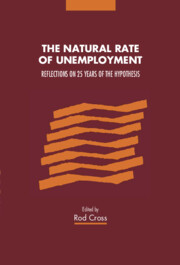Book contents
- Frontmatter
- Contents
- List of Contributors
- Preface
- 1 Introduction
- Part I The theoretical framework
- Part II Adjustment, ranges of equilibria and hysteresis
- Part III Empirical tests and macro models
- Part IV Political economy
- 15 Is the natural rate of unemployment a useful concept for Europe?
- 16 The natural rate of unemployment: a fundamentalist Keynesian view
- 17 Politics and the natural rate hypothesis: a historical perspective
- Index
15 - Is the natural rate of unemployment a useful concept for Europe?
Published online by Cambridge University Press: 03 May 2011
- Frontmatter
- Contents
- List of Contributors
- Preface
- 1 Introduction
- Part I The theoretical framework
- Part II Adjustment, ranges of equilibria and hysteresis
- Part III Empirical tests and macro models
- Part IV Political economy
- 15 Is the natural rate of unemployment a useful concept for Europe?
- 16 The natural rate of unemployment: a fundamentalist Keynesian view
- 17 Politics and the natural rate hypothesis: a historical perspective
- Index
Summary
With increasing integration between the European economies, and with full monetary union planned for the end of the century, it has become commonplace to examine performance indicators and policy concepts at the level of European averages. But such indicators can be highly misleading because no member economy need lie at or even near the average. Similarly, an improvement in the average need not imply an improvement for all, or even a majority of, participants. At the very least we need to know how our performance indicators would be affected by changes in the dispersion in national performance levels. More generally, interactions between the national markets means that the distribution of activity levels can have a profound effect on the level of performance in the aggregate even when monetary conditions remain constant. Given this, the usual performance measures and policy concepts are hardly likely to be either stable enough at the European level, or well enough focused, to be of much use for policy purposes.
This chapter therefore examines the extent to which using European averages for policy purposes, and the concept of a European natural rate of unemployment in particular, may be misleading. Our purpose is to show how the process of aggregating labour markets contributes towards worsening the natural rate of unemployment, and hence the EU's medium-term sacrifice ratio or inflation–unemployment trade-off. We show that if the variation in unemployment rates is taken into account, the aggregate sacrifice ratio will move up and to the right of the average of the national/regional curves.
- Type
- Chapter
- Information
- The Natural Rate of UnemploymentReflections on 25 Years of the Hypothesis, pp. 315 - 345Publisher: Cambridge University PressPrint publication year: 1995
- 3
- Cited by



